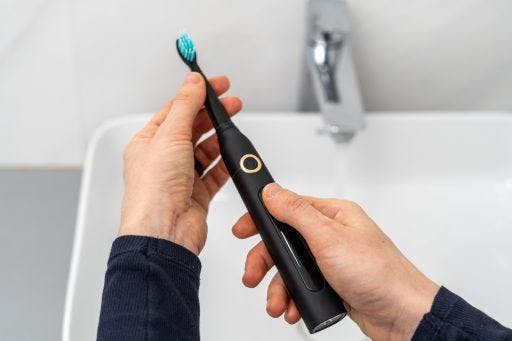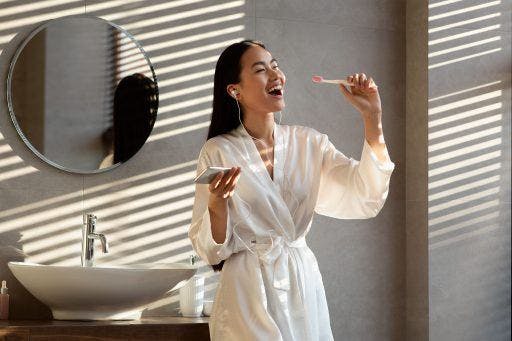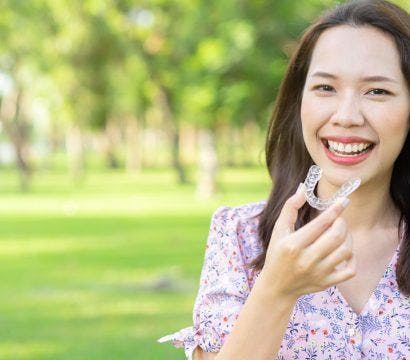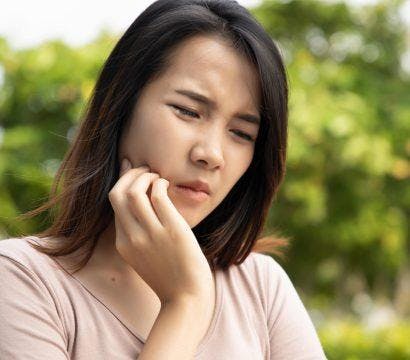Remember when you first learnt to brush your teeth? The strawberry-flavoured toothpaste and colourful brushes were like loyal friends who helped you along the way. Eventually, brushing teeth became so ingrained in your routine that you can do it with your eyes closed.
But everyone – not just children – needs a refresher on proper toothbrushing practices every now and then. And, as dental technology levels up, you, too, should upgrade your toothbrushing game! Follow this guide on taking care of your teeth like a pro.
A step-by-step guide to brushing your teeth
Brushing your teeth requires proper tools and techniques. You can’t just squeeze the cheapest toothpaste on a random toothbrush and scrub back and forth for five seconds and call it a day. If you want to practise proper hygiene, you need to follow these steps carefully.
1. Choose a toothbrush with soft bristles.

The vast range of colours, shapes, materials, and brands in the toothbrush aisle may be overwhelming. Some are cheaper than others, but don’t choose based on the price alone.
Look at the bristles. The American Dental Association recommends soft-bristled toothbrushes to prevent wearing away your gums. The thinner fibres also reach food debris and plaque stuck in your mouth’s deepest crevices.
The shape of the bristles matters, too. Studies show that angled bristles and multidirectional electric toothbrushes remove plaque better. And to answer the long-debated electric vs. manual toothbrush, the former is the superior option in controlling plaque and gingivitis.
According to Clinical, Cosmetic and Investigational Dentistry, powered toothbrushes have automated movement and sensors to help you master a more productive toothbrushing technique.
2. Use the right toothpaste for your needs.
Many toothpaste commercials claim that their toothpaste is dentist-recommended. However, take that with a grain of salt. Be a smart shopper and choose a toothpaste based on your dental needs.
If you love sweet food or have no oral issues, use a fluoride-based option that coats the outer layer of the teeth (enamel) to prevent cavities. Feel a sharp pain every time you eat or drink something cold? Grab yourself a toothpaste intended for sensitive teeth. This type usually has desensitising ingredients like potassium nitrate to protect the nerves inside the tooth.
Whitening toothpaste is a popular choice, especially for coffee drinkers. However, check with your dentist first. Whitening formulas are usually more abrasive in order to wipe stains off the enamel. For those with bleeding gum problems, go with antimicrobial ingredients like triclosan.
3. Angle your brush.
Did you know the side-to-side sweeping technique is ineffective at removing plaque? According to Dental Research Journal, the horizontal method can cause gum recession or the thinning of gum tissues. There are better and safer brushing techniques at your disposal.
The highly rated way to brush your teeth is the Modified Bass technique. It requires you to position your toothbrush at a 45-degree angle with the bristles covering half your tooth and gum. Then, move the brush in a circular movement and flick it outwards, away from the gum.
A European Journal of Molecular and Clinical Medicine study reports that this technique significantly reduces plaque and gum inflammation. The only downside is it’s difficult to practise if you have stiffness or pain around your wrist.
People with sensitive teeth should try the rolling technique. Align the base of the bristles with your gumline and roll the toothbrush away. Repeat on each tooth. Be mindful of the pressure you’re putting on your teeth. Don’t muscle through; focus on being thorough.
4. Take your sweet time.

Brushing teeth should be a part of your self-care routine. After all, a smile is arguably the best accessory anyone can have. Be generous with the time you spend on your dental care.
What is the correct way to brush your teeth? According to the American Dental Hygienists Association, brushing for three minutes removes 55% more plaque than brushing for 30 seconds. This recommendation is one minute longer than Australian Dental Association’s two-minute suggestion. Your sweet spot should be around two and a half minutes.
5. Brush your tongue.
See that white film coating your tongue? It’s a home for bad breath-causing bacteria. Use your toothbrush to clean your tongue. Put a small amount of toothpaste and scrub your precious tasting muscles gently. Rinse with water, and your mouth will feel minty fresh.
Do your tongue a solid by scraping it twice a day after brushing.
6. Sanitise your toothbrush.
Your toothbrush works hard to maintain your oral health, so return the favour by giving it a good clean.
A Journal of Dentistry study says soaking toothbrushes in mouthwash for seven minutes can kill 85% of bacteria. Getting rid of the majority of the germs from your mouth and your toilet (!) that may stick to your toothbrush.
5 essential tips for brushing your teeth
Follow these additional tips to level up your brushing habits:
1. Choose fluoride always.
When you’re toothpaste shopping and can’t decide among all the varieties, make sure that whatever you pick has fluoride. Fluoride not only prevents cavities but also strengthens teeth.
2. Don’t forget to floss.
Flossing removes plaque and food particles between teeth, along the gum line, and in other areas your bristles usually can’t reach. Regular flossing helps prevent gum disease, cavities, and bad breath.
3. Don’t brush too hard.
People often believe brushing quickly but aggressively offers the same benefits as brushing carefully. The former can risk abrasion, which can wear down your teeth easily, as well as cause gum damage. Moreover, you’re more prone to miss hard-to-reach areas when you scrub recklessly.
4. Timing is everything.
When the dentist tells you to brush at least twice a day, this doesn’t mean you should brush twice at any time you wish. Ideally, brush after waking up and before breakfast, eliminating the bacteria and plaque that accumulated overnight.
You should also brush 30 minutes after eating. It helps protect your enamel from erosion caused especially by acidic food.
5. Dental hygiene isn’t limited to toothbrushing.
A healthy diet and good habits (like not smoking or drinking excessively) can help promote better dental health.
Frequently asked questions about brushing teeth
Here are answers to common questions on brushing:
What is the correct routine to brushing teeth?
Brush your teeth at least twice daily (once in the morning and before sleeping). Look for a toothpaste with fluoride to delay enamel breakdown and prevent decay. Angle the brush 45 degrees towards the gums. This position allows you to get any debris stuck near the gums, allowing you to massage them a bit and encourage circulation.
If you’re using aligners like ClearCorrect, you need to make sure you sanitise them, too, as per your orthodontist’s instructions.
What is the 3-3-3 rule for brushing teeth?
The 3-3-3 rule refers to brushing three times a day within three minutes after a meal and at least three minutes every time. While this guideline is good, you don’t necessarily have to follow it.
Aggressive brushers who brush three times a day may cause gum damage or wear the enamel thin. But if you constantly consume acidic foods or beverages, you may need to brush more frequently to wash away lingering acid that can cause tooth decay.
The general rule is to brush twice a day – but you must do this meticulously. Use fluoride toothpaste, floss after meals, and brush gently but thoroughly.
Will brushing three times a day make my teeth whiter?
The goal of brushing your teeth is to remove debris and other plaque-building grime from your pearly whites. It can help prevent enamel erosion, which can cause your teeth to yellow.
While brushing your teeth can delay the staining effects of habits like smoking or drinking tea, wine, or alcohol, it can’t exactly whiten your teeth. You may need whitening toothpaste or other whitening-specific treatments.
What will happen if I don’t brush my teeth?
Bacteria and plaque can build up in your mouth. They can lead to bad breath, tooth decay, and gum problems. More severe cases can even cause heart disease or diabetes.
A good toothbrush, fluoride toothpaste, and proper brushing teeth procedure can turn your smile from ordinary to charming. Take it further by using clear aligners for the ideal set of pearly whites.
ClearCorrect gives you that confidence boost thanks to its ClearQuartz technology that precisely and comfortably straightens crooked teeth. The innovative flexible inner layer enhances comfort during the aligner treatment, from insertion and throughout aligner wear. Plus, no one will notice you’re wearing an aligner, thanks to its high, flat trimline and stain-resistant quality.
When brushing teeth, remember these steps. Make your teeth and dentist proud!
References:
Aggarwal, N., Gupta, S., Grover, R., Sadana, G., & Bansal, K. (2019). Plaque Removal Efficacy of Different Toothbrushes: A Comparative Study. International Journal of Clinical Pediatric Dentistry, 12(5), 385–390.
Bok, H. J., & Lee, C. (2020). Proper Tooth-Brushing Technique According to Patient’s Age and Oral Status. International Journal of Clinical Preventive Dentistry, 16(4), 149–153.
Jain, Y. (2013). A comparison of the efficacy of powered and manual toothbrushes in controlling plaque and gingivitis: a clinical study. Clinical, Cosmetic and Investigational Dentistry, 3.
Suhasini, S., M. V. D. J. (2020, December 13). Brushing Techniques. European Journal of Molecular and Clinical Medicine, 7(2), 6601-6611.
The effect of brushing time and dentifrice on dental plaque removal in vivo. (n.d.). PubMed.
Toothbrushes. (n.d.-b). American Dental Association.



